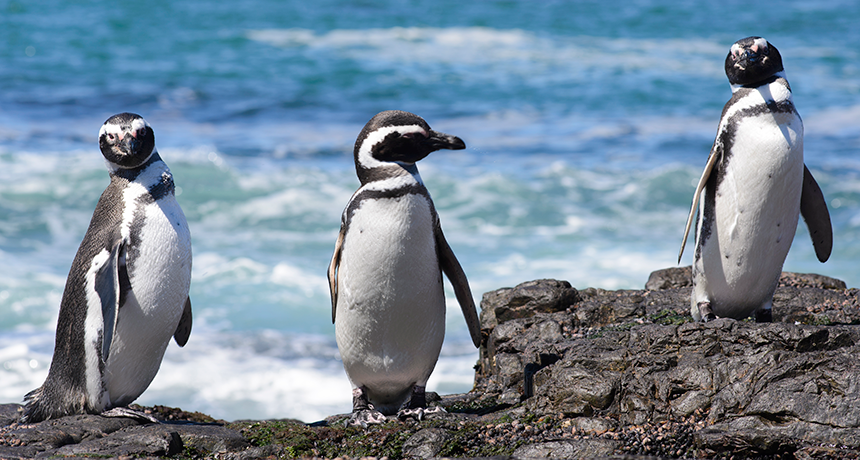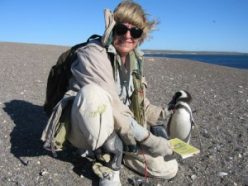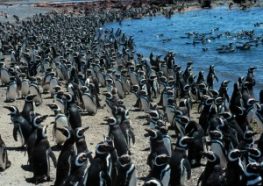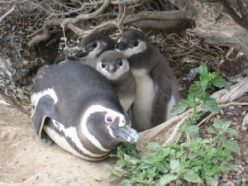Penguin pressure
Scientists are racing to learn as much as they can about penguins in the hopes of saving them from an uncertain future.

Dee Boersma studies how to protect populations of Magellanic penguins, such as these, along the Argentine coast.
Buenaventuramariano/iStockphoto
By Emily Sohn

Dee Boersma was studying penguins in Argentina when a local official announced a new plan.
“He wanted to build a boardwalk over 197 [penguin] nests right before hatching,” says Boersma, a conservation scientist at the University of Washington, Seattle. She knew the project would scare the birds and harm their babies. “That was upsetting to me and to others.”
Boersma snapped into action. First, she hid the lumber for the project, so construction couldn’t begin, even though she knew she might get in trouble for interfering. Then, she battled lawyers and the governor. After all, she had already spent more than 20 years fighting for penguins (you can read about her work at www.penguinsentinels.org). She wasn’t about to give up now.
“There are an awful lot of ways we can make it possible for these organisms to live longer,” says Boersma, who had to pay fines for her interference but eventually won this particular battle. After nine long months, the official was fired. The boardwalk plan was scrapped. And a road into the fragile area was closed. “We need to continue to be vigilant.”
Penguins need that kind of attention because many of them are in trouble. Of the world’s 19 types of penguin species, 14 are classified as threatened or endangered, meaning that their numbers are low enough to make scientists worry about the species’ long-term survival. Even those that are doing OK face an uncertain future. The presence of people is one problem. Climate change is another.
An unusual ambassador

Penguins are not your typical birds. For one thing, they can’t fly. Instead, these spunky creatures spend some of their time on land and ice, where they waddle and tummy-slide. They spend the rest of their time in water, where they swim with surprising speed and grace. Penguins live mostly in the Southern Hemisphere, from New Zealand to South America to Antarctica.
Oh, and they’re cute—really, really cute. With their big round tummies, stubby wings, silly way of shuffling along, and a color pattern that looks like a tuxedo, penguins have a way of getting under your skin.
On a trip to Australia, I once watched as swarms of Little Penguins (the smallest species of penguin at just over a foot tall) popped out of the water, speed-waddled across the beach, and hopped into burrows in the sand. I had to fight the urge to pick one up and bring it home with me.
“Everybody gets charmed by them once they’ve had any kind of interaction with them,” says Gerald Kooyman, a marine biologist at the Scripps Institution of Oceanography in La Jolla, Calif. “That’s one of their strong points as ambassadors to the environment.”
In other words, penguins are so delightful, they can draw our attention to problems that face many other kinds of plants and animals as well. The number of people on Earth, for one thing, keeps going up. Our shopping malls, neighborhoods and roads are rapidly destroying the habitats where wild animals live. Pesticides, industrial chemicals and other sources of pollution get into the environment and make animals sick.
Global warming, too, is causing troubles in a whole bunch of ways. In general, a rise in heat-trapping gases in the Earth’s atmosphere is making both the air and the oceans warmer. Unlike humans, animals can’t just change their outfits or go inside and turn on the air conditioning when weather turns sour. Instead, changes to their environment can make it harder for them to find food, reproduce or even survive.

As our planet continues to get warmer, scientists are also noticing shifts in winds and currents. Even more complicated, climate is becoming increasingly variable. That means lower low temperatures, higher highs, and more surprises. These are all things that can put a lot of stress on animals, including penguins.
“There are severe changes going on,” Boersma says. “Penguins are doing everything in their ecological power to try to adapt to climate change. But it’s coming fast, and we’re already seeing impacts.”
For better or worse
Some types of penguins are doing worse than others.
In Argentina, the world’s largest population of Magellanic penguins lives within a protected reserve called Punta Tombo. That’s where Boersma works. But in the last few decades, the scientists have seen the population at Punta Tombo drop from 350,000 pairs to 200,000 pairs. (These birds have a tendency to couple up).
For the penguins that remain at the site, studies show, life is harder than it used to be. One reason is that their food—small fish and squid—have moved further north, as a result of climate change. So, the birds now have to swim an average of 37 miles farther, each way, to find food to bring back to their chicks. Thirty-seven miles is a long way for a bird to swim. Consequences can be disastrous.

“If you go a long way and you don’t get back in time,” Boersma says, “your young starve.”
Penguins that live near the South Pole face their own problems. Emperor penguins, for instance, breed on the ice. After the moms lay their eggs, they travel to the open sea, where they spend two months feeding. All the while, the fathers keep the eggs warm without eating a single bite.
It’s an exhausting process. Studies show that their lifestyle makes this species highly sensitive to shifts in climate. Just a small environmental change—in temperature or rainfall, say—in any direction can make it harder for the birds to find food. Unfortunately for them, climate is changing particularly fast near the Earth’s poles.
Antarctica’s king penguins are actually doing fine right now, but even for them, there are signs that trouble is brewing. One 2008 study found that warmer water leads to fewer squid, fish and other creatures that the penguins eat.
As hard as penguins may try, these birds can’t always find ways to cope with the changes happening around them. Some of Punta Tombo’s penguin pairs have moved more than 100 miles north in pursuit of food. But their new homes lie on built-up areas and private land, where safety is not guaranteed.
Not all penguins have the option of moving to greener pastures when conditions decline. The penguins that live in the Galapagos Islands, for one, live hundreds of miles from other bodies of land. When things get bad, they have nowhere else to go.
Race against time
Despite the growing list of concerns, not all penguin news is bad news.
Some species continue to thrive, including king penguins and certain populations of Adélie penguins. Even amongst troubled species, some populations are better off than they used to be.
In the 1980s, Boersma says, there were years when 80 percent of dead Magellanic penguins found on the beach in Punta Tombo were completely drenched in oil. Since then, officials have cracked down on illegal oil dumping. Today, that problem has mostly disappeared.
“You really can have an influence when you want to solve these problems,” Boersma says. “Humans are good at sometimes changing and reducing their impacts on species.”
As efforts to protect penguins continue, scientists are racing to learn more about these charismatic birds. Penguins spend as much as 80 percent of their lives at sea, where they perform impressive physical feats. Some species dive as deep as 2,000 feet. Some swim hundreds of miles each year. But most studies have focused on what the birds do when they’re above the surface.
In recent years, researchers have begun to attach tracking devices to penguins to learn where the birds go and what they do when they’re underwater. The results are revealing new details about both penguins and the environment.
“Penguins can be used to essentially map those parts of the oceans that they frequent,” says Lloyd Spencer Davis, a penguin filmmaker, author and scientist at the University of Otago in New Zealand. “Also, by monitoring how easily or difficult they find it to get food, they can be used as a check on the health of the seas.”
The more we learn about penguins, he adds, the more hope we have for keeping them alive.
“We are responsible for the penguins’ current woes,” Davis says. “But we can be their saviors, too.”







